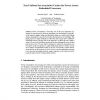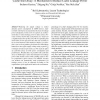71 search results - page 1 / 15 » Snug set-associative caches: reducing leakage power while im... |
ISLPED
2005
ACM
13 years 10 months ago
2005
ACM
As transistors keep shrinking and on-chip data caches keep growing, static power dissipation due to leakage of caches takes an increasing fraction of total power in processors. Se...
HIPEAC
2007
Springer
13 years 11 months ago
2007
Springer
Abstract. In this paper, we propose a novel approach to reduce dynamic power in set-associative caches that leverages on a leakage-saving proposal, namely Cache Decay. We thus open...
EUC
2004
Springer
13 years 10 months ago
2004
Springer
Abstract. Power consumption is becoming one of the most important constraints for microprocessor design in nanometer-scale technologies. Especially, as the transistor supply voltag...
PACS
2000
Springer
13 years 8 months ago
2000
Springer
Reducing the supply voltage to reduce dynamic power consumption in CMOS devices, inadvertently will lead to an exponential increase in leakage power dissipation. In this work we ex...
DSD
2008
IEEE
13 years 6 months ago
2008
IEEE
We evaluate the leakage reduction for both instruction and data cache in presence of drowsy or decay techniques. We discovered that a filter cache, traditionally used for reducing...


